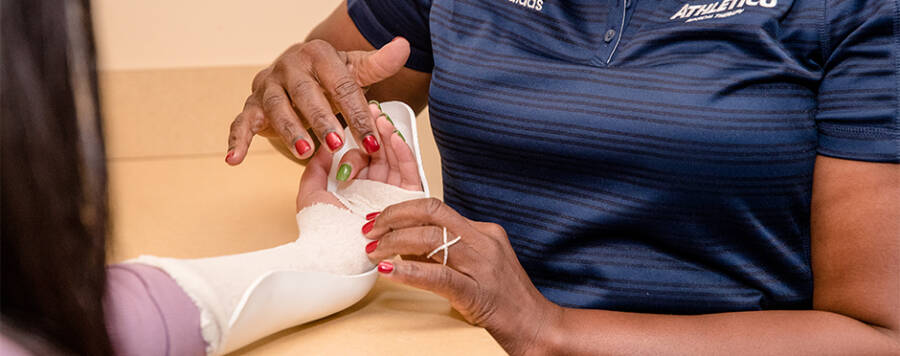What is Occupational Therapy?
This is a question I can say with great certainty that every Occupational Therapist is asked, and I would bet we all have a quick elevator speech memorized and ready to recite. Here goes mine. Occupational Therapists work in a variety of healthcare settings including outpatient, skilled nursing facilities and hospitals, pediatric settings in schools and in the home, and work and industrial rehabilitation just to name a few.
There are eight areas of occupations in total, and an Occupational Therapist is educated and trained to look at all barriers, deficits, and limitations someone may have within each of these areas of occupations.1 This is the foundation we use to set-up our treatment plan with any individual to promote healing, recovery, independence, function, and inclusion. This is also where a lot of the confusion arises since an occupation is not necessarily what you might think. It does not just mean what your job or profession is – although it could be as we have a strong role in workers’ compensation rehabilitation. We look at occupations as a part of you and all your occupations make up the whole YOU. In other words, occupations are known as any meaningful everyday activity you participate in. These eight areas of occupation include:
- Self-care Activities of Daily Living (ADLs)
- Instrumental Activities of Daily Living (IADLs)
- Work
- Education
- Play
- Leisure
- Social Participation
- Sleep & Rest
As I mentioned, we look at the whole YOU and take a holistic approach when evaluating and working with a patient or client. We are also skilled to look at not only the “Person”, but also the person’s “Environment”, and the person’s “Occupations/Occupational Performance” which all contribute to who we are as individuals. Just as other healthcare professionals, Occupational Therapists are in many different settings and treat conditions across the entire lifespan. We will look at these eight different areas of occupation differently dependent on what setting we may work in, however there can always be overlap throughout the many settings as is the case with other professions.
Here at Athletico, the majority of our Occupational Therapists are also Hand Therapists and Workers’ Compensation Specialists. We work with our patients to regain function of their hands and upper extremities from the finger tips to the shoulders, and to help break down barriers that may impact their road to recovery. These injuries and conditions may originate from a traumatic work injury, chronic or acute condition, or result from a cumulative repetitive stress injury – to just name a few. Activity modification and adaptive equipment are other areas of an Occupational Therapist’s expertise and the tools we may choose to assist in our treatments to help our patients meet their goals. We also use our skills and advanced training in orthosis fabrication to make custom upper extremity orthoses (aka splints) using a variety of thermoplastic materials, Velcro, and padding to help support the healing structures of the upper extremity and to promote a favorable recovery.
An Occupational Therapist plays a vital role in helping people regaining function. We tend to use tools or perform activities the average observer may think are different or out of the norm in terms of rehabilitation. However, by using therapeutic activity-based treatment we are stimulating participation and engagement and making the task at hand more meaningful and fun. In fact, we Occupational Therapists like to joke that we put the “FUN” in “FUNctional” with our unconventional, outside of the box thinking in terms of treatment and home exercise programs.
Throughout Occupational Therapy Month, I would like to applaud and show special appreciation to all my fellow Occupational Therapist colleagues and say thank you for all you do in advancing our profession and more importantly, helping our patients living life to their fullest. As is with any large group as diverse as Occupational Therapy, it is nearly impossible to define each and every aspect of our profession. However, one quote from the American Occupational Therapy Association that really resonates with me and I feel sums an Occupational Therapist better than anything else I have seen, and the biggest takeaway from my blog is, “OT is where Science, Creativity, and Passion collide.”2
If you would like to learn more from an Athletico occupational therapist, please use the button below to request an appointment.
Find an Occupational Therapist Near You
The Athletico blog is an educational resource written by Athletico employees. Athletico bloggers are licensed professionals who abide by the code of ethics outlined by their respective professional associations. The content published in blog posts represents the opinion of the individual author based on their expertise and experience. The content provided in this blog is for informational purposes only, does not constitute medical advice and should not be relied on for making personal health decisions.
References:
1. Allison. “Areas of Occupation.” Allison The OT Student, 22 Apr. 2019, allisontheotstudent.home.blog/2019/01/31/areas-of-occupation/.
2. “What Can Occupational Therapy Do For You?” Aota.org, 2017, www.aota.org/About-Occupational-Therapy/Patients-Clients/video-what-ot-can-do-occupational-therapy.aspx.

 width="900"
height="356"
>
width="900"
height="356"
>

1 Comment
Ron Booker
My young son has always struggled to draw, and I thought it was just because he’s a toddler. But when I compared his drawing with a number of his peers, it was not nearly as good. It’s good to know that his difficulty with this task might mean that he has problems with his fine motor skills. I should find a pediatric therapy clinic to take him to address this.